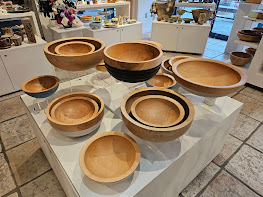Our last full day in Vancouver was rainy, as one would expect in "Raincouver" as locals call it, but we couldn't really complain. The weather had been uncharacteristically sunny and dry for much of our visit, but we had a couple of big outdoor spots on our list yet to see. So, we took the Vancouver City Highlights bus tour offered by Landsea Tours ( Website ). It was a good choice. They offer multiple pick-up spots, and we walked a few blocks from our Airbnb apartment to a hotel. There, we were picked up by a small bus, and our driver and tour guide took us on a thorough and interesting tour of the city.
Stanley Park is a 1,001-acre public park, occupying the northwest half of Vancouver's peninsula. It is about one-fifth larger than Central Park in New York City. Unlike other large urban parks that were generally designed by landscape architects, Stanley Park is mostly the result of natural evolution. Most of the park is densely forested with over a half million trees as tall as 249 feet and many that are hundreds of years old. In the 20th century, a few attractions have been added, but most of the park looks like it did in the 19th century.
Human residence on the the island dates back at least 3000 years, with multiple First Nations occupying the land, primarily the Squamish and Musqueam. European exploration, led by George Vancouver, first occurred in the 1790s. Small European settlements formed, timber operations commenced, and the area became a staging ground for mid-19th century gold rushes. It officially became a park in 1888, named after Lord Stanley (the same Stanley of the Stanley Cup), the 6th Governor-General of Canada.
The most visited part of the park is the collection of totem poles that were first erected there in the 1920s, with original poles dating back to the 1880s. The poles have been refurbished and replaced as needed over the years.
One of Vancouver's biggest tourist attractions is the Granville Island Public Market, a year-round public market for farmers and other vendors established in 1979. Granville Island had previously been the home of many industries producing materials necessary for the forest, mining, and construction industries. Today, only one of those remains, a concrete plant. The draw is the food, and there is plenty of awesome stuff that to appeal to all of the senses. It's the most fun food market we've ever visited. There are also other vendors including galleries, book stores, and artisan clothing and jewelry shops. It is a great place to spend a few hours.




















No comments:
Post a Comment